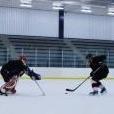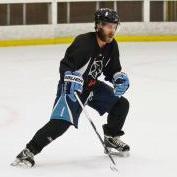-
Content Count
42 -
Joined
-
Last visited
-
Days Won
1 -
Feedback
0%
bootsmagee last won the day on November 22 2017
bootsmagee had the most liked content!
Community Reputation
15 GoodProfile Information
-
Spambot control
521325215
Recent Profile Visitors
-

Sparx Skate Sharpener - At home sharpener
bootsmagee replied to tamtamg's topic in Ice Hockey Equipment
Why's that? A huge selling point of the Sparx is it's ability to maintain profile throughout the life of the steel. -

Sparx Skate Sharpener - At home sharpener
bootsmagee replied to tamtamg's topic in Ice Hockey Equipment
The alignment procedure takes literally 1 minute or less, it's very simple. -

Sparx Skate Sharpener - At home sharpener
bootsmagee replied to tamtamg's topic in Ice Hockey Equipment
Sorry, I didn't see this reply until just now. The grinding ring head (Trolley) runs on a fixed path, yes. If we say the grinding ring moves back and forth on the X-axis to sharpen the skate blade, the grinding ring itself is adjustable in the Y-axis by turning a knob, which has incremental "clicks." A separate height adjustment lever also allows Z-axis adjustment, so you can set the max height of the grinding ring. The grinding ring can then move downward from this setting with a consistent torsional spring pressure pushing the ring back up toward this max height setting. This puts consistent pressure on the grinding surface, taking off consistent amount of material along the entire blade's profile. 2 to 3 clicks of Y-axis adjustment is advertised to change edge height by approximately .001" when using a 1/2" radius ring. So in other words, they're telling us if your edges are off by .001", 2-3 clicks toward the taller edge should set them perfectly even. I work with Autocad and a quick sketch shows me that in order to get .001" height difference bewteen the edges on a 1/8" wide blade, the 1/2" grinding ring would need be approximately .004" off-center, in the Y-axis. So .004/2.5 clicks = .0016"; let's call it .0015" per click in the Y-axis. I also calculate approximately .0004" of edge height (Z-axis) adjustment per click (.001/2.5 clicks=.0004 per click). -

Sparx Skate Sharpener - At home sharpener
bootsmagee replied to tamtamg's topic in Ice Hockey Equipment
Ulster -

Sparx Skate Sharpener - At home sharpener
bootsmagee replied to tamtamg's topic in Ice Hockey Equipment
Yes I always install the travel guard when I'm done using the machine. I made my own case out of a Jr Goalie wheeled hockey bag and polyethylene foam, and the sparx goes back into the case when I'm done. I posted pics a while back, but photobucket sucks and the links are broken. -

Sparx Skate Sharpener - At home sharpener
bootsmagee replied to tamtamg's topic in Ice Hockey Equipment
I understand. Yes, for those who want to fine tune for dead even edges, the alignment tool can be seen as your starting point followed by fine tuning to an edge checker. Honestly, my opinion is that in most cases no one would feel the difference if blind tested with perfect fine tuned edges vs. alignment tool-only edges. In my personal experience with the sparx and my hockey team, the alignment tool does it's job and the edge checker was an unnecessary splurge. We still don't know what's expected to break down first on these machines and when; maybe at some point the edge checker will help show that the machine is past it's alignment accuracy lifespan. Hopefully in the distant future :) I'm not discounting the desire to fine-tune, though. It's fun; rewarding. It kind of relates back to the passion for manual sharpening that's been seen in this thread, and the debates that arise from it. Set it and forget it, or play and tweak. I enjoy feeling confident that the sparx is aligned after using the alignment ring and sight. I check alignment every time I travel with the machine, and I make a 1 or 2 click adjustment maybe 1 out of every 10 trips when I bring it to the rink or a friend's house. -

Sparx Skate Sharpener - At home sharpener
bootsmagee replied to tamtamg's topic in Ice Hockey Equipment
Wut...the alignment tool doesn't suck. Please don't suggest to people that they discard the alignment tool and opt for a carpenter's square. Kudos for figuring out a workaround when you had no alignment ring, but either something is off with your secondhand machine or the method you're using isn't accurate. -

Sparx Skate Sharpener - At home sharpener
bootsmagee replied to tamtamg's topic in Ice Hockey Equipment
The sparx remains centered regardless of blade width. You should really track one down to check it out. I'm about 45 minutes south of Albany if you're ever interested. -

Sparx Skate Sharpener - At home sharpener
bootsmagee replied to tamtamg's topic in Ice Hockey Equipment
If you buy a 9/16" and don't like it, I'll buy it from you. I'm down to my last 9/16 anyway, and will have to buy a backup in the next few months. -

Sparx Skate Sharpener - At home sharpener
bootsmagee replied to tamtamg's topic in Ice Hockey Equipment
Thanks for the feedback. Before I go on here, I am NOT a manual skate sharpener operator which is why I am always curious about the truth behind "manual can do better." I can definitely understand the draw toward manual for someone who wants to learn the true intricacies of sharpening and the craft it becomes with practice. Learning the "feel" you're describing is probably an enjoyable and rewarding process as the craft is learned over time with different steels and sharpening obstacles that come along. That said, the appeal toward the Sparx is that it really does an excellent job and eradicates all of this manual feedback and craftsmanship. That probably sounds like nails on a chalkboard to someone who has fallen in love with the craft of manual skate sharpening, but the truth is that some people have fallen in love with the game of hockey and their focus is on that. They want a consistent feel from their skates throughout the year and the sad truth is that many many shops and sharpening services do not offer this (at their own fault) and the Sparx makes attaining it as easy as pie for anyone willing to put up the money. Sparx offers a great range of hollows. The wheels are diamond abrasive coated steel. They do not last forever, but they also do not change shape during their life cycle. The one great thing about the Sparx that manual sharpening doesn't offer is that the Sparx does not alter the profile throughout the skate blade's life. On the same tune, it cannot give you a custom profile either, which is where manual sharpening would shine in comparison. But once your custom profile is set, it would be there unchanged for the life of the blade. This is a major appeal that isn't often discussed. Have you had a chance to get your hands on a Sparx? If not, I would highly suggest you check one out if at all possible. Not to sway you from manual sharpening, but just to get a real-world feel for what it actually offers. -

Sparx Skate Sharpener - At home sharpener
bootsmagee replied to tamtamg's topic in Ice Hockey Equipment
Could you elaborate on why the manual machine will give you the potential to do a better job vs. a sharpening on the Sparx? I see this comment often in these conversations, but no one offers any specifics. -

Sparx Skate Sharpener - At home sharpener
bootsmagee replied to tamtamg's topic in Ice Hockey Equipment
I don't think there's any way to do it accurately without the alignment ring or an edge checker. You could run your passes and then balance your skate on a glass table; your skate blade should be perpendicular to the glass surface. It's still not a very accurate check, but it would potentially show if it's way out. Need to get that alignment ring, or a replacement one. -

Sparx Skate Sharpener - At home sharpener
bootsmagee replied to tamtamg's topic in Ice Hockey Equipment
They're offering free shipping for Black Friday w/promo code BlackFriday2017 -

Sparx Skate Sharpener - At home sharpener
bootsmagee replied to tamtamg's topic in Ice Hockey Equipment
They're probably out of stock at the moment. I believe they get an overload of ring orders and have a hard time keeping up sometimes. Give them a shout and see what the stock status is. -

Sparx Skate Sharpener - At home sharpener
bootsmagee replied to tamtamg's topic in Ice Hockey Equipment
Just wanted to throw an observation out there; this may be common knowledge to those with experience. I recently received the edge checker from Sparx. I picked one up over the holiday since they offered a sale price. I've used it on about 6 pairs of skates run through the Sparx and figured out something interesting. On the first few skates, I was able to confirm that the Sparx was adjusted properly and the edges tested very close to perfect; off by no more than a single engraved line thickness on the edge checker (not a line-to-line "bar" as in like .06", but actual engraved line thickness as in .01-.02") Then I sharpened my GF's skates and a pair of small child's skates for a friend. I noticed that these were testing way off when using the edge checker. I determined that it must be from the lower quality steel of the cheaper skates which isn't actually flat, even on the vertical face top-to-bottom. When clamping the edge checker and holding it up to a bright light, I could see that the banking edge would not sit flush with the steel; there was a visible gap along it's face and the edge checker could be rocked side to side making the gap open and close top-to-bottom. Flipping the edge checker 180-degrees to bank on the other side of the steel helped in one case, but not the other.






